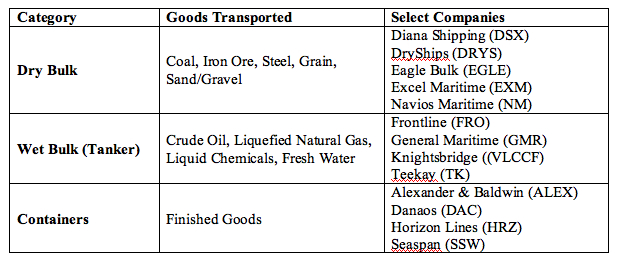股色股香
博客內容大多數收集於網上,如有版權之糾紛,敬請告知。
When selecting companies to invest in, one needs to be conscious of both demand and supply drivers. Demand drivers look at the availability and need for the cargo being transported while supply drivers look at the ability of ship builders to construct ships for commercial use.
The two primary drivers of demand are trade growth and trade patterns.
Trade Growth (Demand Driver)
- World GDP growth – the higher the level of economic activity the greater the demand for raw materials to trade
- Oil demand and supply – the higher the demand and supply of oil, the greater the need for tankers to transport
- Oil inventory levels – the amount of oil held in storage to meet future requirements has an impact on the demand for oil tankers in the future; seasonality often plays a critical role
- Steel production – Since iron ore and coal represent about 42% of global dry bulk trade, steel production is a significant factor in determining the demand for dry bulk carriers
Trade Pattern (Demand Driver)
- Refinery locations – varying levels of capacity and the sophistication of refineries’ processing capabilities affect the oil markets
- Sourcing – The distance between the place of origin and place of destination affects tonnage-mile demand for vessels
- Regional grain production – global grain trade depends on harvest of a particular year which, can significantly affect supply of cargo to transport
The two primary drivers of supply are ordering and scrapping
Ordering (Supply Driver)
- Ship building capacity – ship builders generally cannot cope with sudden increases in demand due to a time constraint to making ships; the current backlog of global shipyards reach out as far as the mid 2010’s
- Ship building prices – Lower prices can lead to increased orders thereby increasing the total tonnage available in the market
Scrapping (Supply Driver)
- Economic life – The higher the age of the fleet the higher the expected scrapping and lower the net fleet growth; the current average age of global shipping fleet is 19 years
- Regulations – Regulations on age and safety set by the International Maritime Organization and the EU can place restrictions on the particular kinds of vessels and fleets
Current Outlook Attractive
The demand for shipping capacity has been soaring for years thanks to places like China, India and the Middle East for their increasing needs and participation in global trade; this has pushed freight rates and operator profits up significantly. Luckily, supply of raw materials has kept in pace with demand, and thus has not constrained shipping activity. In addition, fuel costs are promoting a growing number of shippers to consider ocean versus other forms of transport.
A particularly attractive feature of shipping companies is that dividends are generally high and can range anywhere from 5-15% depending on the company; this can add significant bottom-line returns for your portfolio, even if the stock or market underperforms.
=======================================================================
台灣的Nobu Su在船運界的任何時期都會是位傑出人物。他看上去十分謙遜,而一位對手對他的描述是“酷愛冒險”。
作 為波動較大、相對新生的運費期貨市場上一名熟練的玩家,Su還使自己的公司TMT成為一家油輪及幹散貨船的主要運營商。2002年父親去世後他接管了 TMT,此後僅僅6年時間就取得了上述成就。TMT原名台灣海運公司(Taiwan Maritime Transportation),現在被重新命名為Today Makes Tomorrow。
“他前途遠大,”一位船舶經紀人這樣描述這位全球大船東。而在5年前,人們對他基本上還一無所知。
目前,大多數船運公司正變得越來越透明,運作與普通公司更為相近,在這個時代,現年49歲的Su更顯得與眾不同。
私有的TMT從未公布過財務數據。Su去年秋天才第一次接受媒體采訪,他對TMT運營的船隻數量也含糊其辭。
“數字總是在起起伏伏,大概在90至150艘之間,”他表示,“有記得有人說是130艘。”
不過,Su之所以成為國際船運界最具爭議的人物,是TMT的船隊和該公司買賣基於未來航運成本的金融產品行為之間的瓜葛。
該 公司許多競爭對手認為,TMT努力將船舶租賃費率向著其在遠期運費協議(FFA)市場上高風險大額押注的方向推動,而該公司實物船舶的交易策略一定程度上 受到這種努力的左右。競爭對手聲稱,當TMT押注FFA價格下降時,往往會提供低於市場價格的租船費率。而當TMT押注FFA價格上漲時,又會撤離市場 ——從而降低運力,推高價格。
這種行為算不上不道德,但遠遠超出了大多數航運公司利用紙貨市場來對衝市場風險的有限範圍。
Su有意淡化TMT在紙貨市場上的角色,隻是表示它是“一個重要參與者”。然而,與該公司有關聯的人士曾聲稱,TMT在全球FFA交易總量中占30%的份額。




